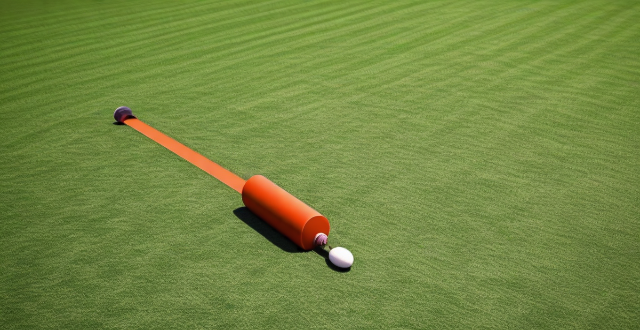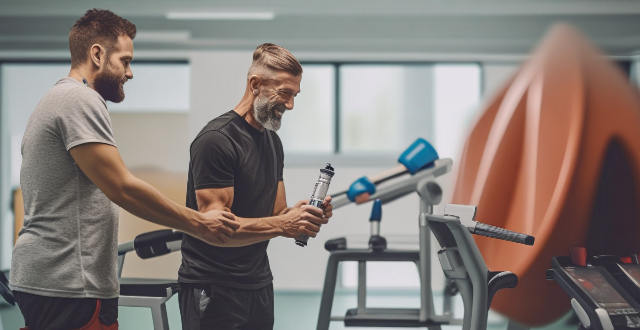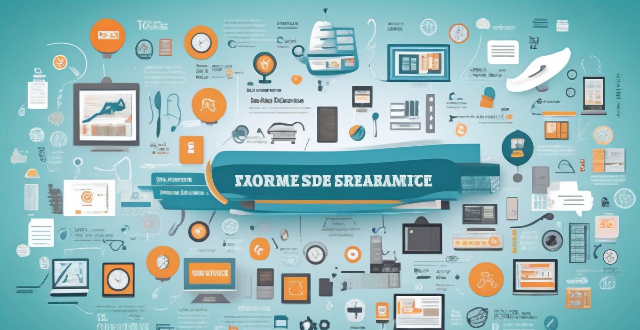Lead Sports

Can sports help individuals achieve their personal goals ?
Sports have been an integral part of human civilization for centuries. They are not only a source of entertainment but also serve as a platform for personal growth and development. Many individuals engage in sports to achieve their personal goals, be it physical fitness, mental well-being, or social interaction. One of the most obvious benefits of sports is improved physical health. Engaging in regular physical activity can lead to reduced risk of chronic diseases such as heart disease, diabetes, and obesity, strengthened bones and muscles, improved cardiovascular health, and better sleep quality. Sports can also aid in weight management by burning calories and increasing metabolism, leading to weight loss or maintenance. Engaging in sports can help reduce stress levels by releasing endorphins, which are natural mood boosters. This can lead to improved mood and reduced anxiety, as well as better coping mechanisms for stressors in life. Participating in sports can also boost self-esteem by providing a sense of accomplishment and pride, leading to increased confidence in one's abilities and improved body image and self-worth. Sports often require teamwork and communication, which can help individuals develop these skills outside of the sporting arena. This can lead to improved interpersonal relationships and enhanced leadership abilities. Participating in sports can also provide networking opportunities, allowing individuals to meet new people who share similar interests. This can lead to new friendships and professional connections, as well as an expanded social circle and support system. In conclusion, sports can play a significant role in helping individuals achieve their personal goals. Whether it be physical fitness, mental well-being, or social interaction, sports offer numerous benefits that can positively impact various aspects of one's life. By engaging in sports regularly, individuals can work towards achieving their personal goals while enjoying the many benefits that come with it.

What are the psychological benefits of participating in sports ?
Participating in sports can have numerous psychological benefits that extend beyond physical health. Here are some of the key advantages: - **Improved Mood and Reduced Stress**: Boosts endorphins, decreases cortisol levels, and helps to lower stress. - **Enhanced Self-Esteem and Confidence**: Achievement and mastery in sports boost self-esteem, while social interaction increases confidence. - **Better Sleep Quality**: Regular exercise leads to physical fatigue and relaxation, improving sleep patterns. - **Increased Resilience and Mental Toughness**: Overcoming adversity in sports builds resilience, while goal-oriented pursuits foster mental toughness. - **Social Support and Connection**: Teamwork and camaraderie provide a network of support, while shared experiences create bonds and friendships. - **Improved Cognitive Function**: Studies suggest regular exercise can lead to increased brain volume and improved cognitive function. - **Emotional Regulation and Coping Mechanisms**: Sports provide an outlet for expressing and managing emotions like anger or frustration, and athletes learn to cope with high-pressure situations. - **Positive Addiction and Avoidance of Unhealthy Habits**: Sports can become a positive addiction, replacing less healthy habits, and require time management, reducing idle time that could lead to unhealthy behaviors.

Can playing sports lead to a sense of accomplishment and pride ?
Playing sports can lead to a sense of accomplishment and pride through physical fitness, teamwork, skill development, and overcoming adversity. Achieving personal fitness goals, collaborating with teammates, mastering sport-specific skills, and bouncing back from challenges all contribute to feelings of satisfaction and self-worth. Engaging in sports is not just about recreation but also about personal growth and development.

Can taking sports nutrition supplements lead to health risks or side effects ?
Sports nutrition supplements can enhance performance and recovery but may pose health risks and side effects such as overdosing, contamination, interactions with medication, and allergic reactions. However, when used appropriately, they can also improve performance, increase muscle mass, aid in recovery, and replenish nutrients. It is crucial to research each supplement, follow recommended dosages, and consult with a healthcare professional to minimize risks and maximize benefits.

How long does a lead-acid battery last ?
Lead-acid batteries are commonly used in various applications, including vehicles, uninterruptible power supplies (UPS), and renewable energy storage systems. The lifespan of a lead-acid battery depends on several factors, such as its type, usage, and maintenance. In this article, we will discuss the typical lifespan of lead-acid batteries and provide tips for extending their service life.

How does a lead-acid battery work ?
Lead-acid batteries work on the principle of converting chemical energy into electrical energy and vice versa. They consist of an electrolyte, plates, and separators. During charging, an external power source applies a voltage higher than the open-circuit voltage of the battery, causing lead sulfate on the positive plate to be converted back into lead dioxide and on the negative plate into metallic lead. During discharging, when a load is connected to the battery, lead dioxide on the positive plate is reduced to lead sulfate, and metallic lead on the negative plate is oxidized to lead sulfate. The electrons flow from the negative terminal of the battery to the load during discharging and from the positive terminal of the external power source to the positive plate of the battery during charging.

What are the potential risks associated with children specializing in one sport too early ?
Specializing in a single sport at an early age can have both advantages and disadvantages for children. While it may lead to improved skill development and potential for higher-level competition, there are also several potential risks associated with this approach. These include physical risks such as overuse injuries, burnout, and lack of cross-training benefits; psychological risks like pressure and stress, narrowed social experiences, and fear of failure; developmental risks including delayed skill development, loss of childhood, and reduced adaptability; social risks such as isolation, peer pressure, and limited life skills; and academic risks such as time management challenges and prioritization issues. To mitigate these risks, experts often recommend encouraging diverse participation in sports until late adolescence, ensuring a balanced approach between sports, school, and leisure time, providing access to mental health resources for athletes dealing with stress and pressure, and involving parents in a supportive but not pushy way.

Can you recharge a dead lead-acid battery ?
Recharging a dead lead-acid battery is possible, but it depends on the condition of the battery and how long it has been discharged. Here are some steps to follow when attempting to recharge a dead lead-acid battery: Check the battery's condition, determine the battery's voltage, choose the right charger, connect the charger to the battery, monitor the charging process, and test the battery after charging. In summary, recharging a dead lead-acid battery is possible as long as the battery is in good condition and the correct charging procedures are followed.

What is the difference between a sealed and unsealed lead-acid battery ?
Sealed lead-acid batteries are maintenance-free and have a longer lifespan than unsealed batteries. They also have a lower self-discharge rate and no risk of acid spillage. Unsealed lead-acid batteries require regular maintenance, including checking the electrolyte level and adding distilled water when necessary. They generally have a shorter lifespan and a higher self-discharge rate compared to sealed batteries. There is also a risk of acid spillage if the battery is damaged or mishandled.

Can cultural fusion lead to a loss of cultural identity ?
Cultural fusion, the blending of different cultures, has been a phenomenon for centuries. However, with globalization and the rise of social media, cultural fusion has become more prevalent than ever before. While it can lead to the creation of new and exciting cultural expressions, it can also raise concerns about the potential loss of cultural identity. This article explores whether cultural fusion can indeed lead to a loss of cultural identity by examining the benefits of cultural fusion, the potential loss of cultural identity, and ways to maintain cultural identity amidst fusion.

How can you maintain a lead-acid battery to extend its lifespan ?
Lead-acid batteries are commonly used in vehicles, UPS, and solar storage systems. To ensure their longevity, it's essential to maintain them properly. Here's how you can extend the lifespan of your lead-acid battery: prevent overcharging, avoid deep discharges, maintain proper fluid levels, keep the battery clean, and store properly when not in use. By following these maintenance tips, you can significantly extend the lifespan of your lead-acid battery and ensure reliable performance for years to come.

What are the safety precautions to take when handling lead-acid batteries ?
When dealing with lead-acid batteries, it's crucial to follow certain safety precautions to protect yourself and your surroundings. Here are some essential guidelines: ### Personal Protective Equipment (PPE) - Always wear goggles to protect your eyes from acid splashes or lead particles. - Use acid-resistant gloves to prevent skin contact with battery acid. - Wear long sleeves and an acid-resistant apron to protect your clothing and skin. - Consider using a face shield if working in an environment where battery explosion is possible. ### Ventilation - Ensure proper ventilation when charging, testing, or working near lead-acid batteries. - Avoid breathing in the fumes released by the batteries. ### Handling - Lift batteries carefully to avoid straining your back or dropping them. - Keep batteries upright to prevent acid leakage. - Do not place metal objects across the terminals to avoid short circuiting. ### Charging - Charge batteries in a well-ventilated area away from flames or sparks. - Use a dedicated charger suitable for the specific type of lead-acid battery you are charging. - Never overcharge the battery as it can cause damage or even explosion. ### Storage - Store batteries in a cool, dry place away from direct sunlight. - Keep them on a non-conductive surface to prevent short circuits. - Ensure that the storage area is well-ventilated. ### Disposal - Do not dispose of lead-acid batteries in regular trash. - Take them to a certified recycling center or a facility that accepts hazardous waste. - Clean up any spilled acid immediately with a solution of baking soda and water, then dispose of the cleaning materials properly. ### First Aid - If acid comes into contact with your skin, wash immediately with plenty of water and seek medical attention if necessary. - In case of eye contact, flush your eyes with water for at least 15 minutes and get immediate medical help. ### Training - Make sure you are trained in the correct procedures for handling lead-acid batteries. - Stay informed about the latest safety practices and equipment.

How often should you replace a lead-acid battery in a car ?
Replacing the lead-acid battery in your car is crucial for maintaining its performance and reliability. The lifespan of a lead-acid battery can vary depending on various factors, such as usage, maintenance, and environmental conditions. In this article, we discussed how often you should replace a lead-acid battery in a car. Before diving into the replacement frequency, it's essential to understand the factors that can affect the lifespan of a lead-acid battery. These factors include usage, maintenance, environmental conditions, and manufacturer. Frequent short trips, neglecting regular maintenance, extreme temperatures, and differences in materials and construction can all impact the battery's lifespan. For vehicles that are used regularly, it is generally recommended to replace the lead-acid battery every 3-5 years. However, this can vary based on the factors mentioned above. If you take good care of your battery and maintain it properly, it may last longer than 5 years. On the other hand, if you frequently expose your battery to harsh conditions or neglect its maintenance, it may need replacement sooner. If your vehicle is used infrequently, the lead-acid battery may not get enough time to recharge fully between uses. In such cases, it is advisable to replace the battery every 2-4 years to ensure reliable starting and avoid being stranded with a dead battery. Regardless of the age or usage of your battery, there are certain signs that indicate it may be time for a replacement. These signs include slow starting, dim headlights, corrosion, and age. It is generally recommended to have your battery tested by a professional if it is more than 5 years old to determine its remaining lifespan. In conclusion, replacing the lead-acid battery in your car is an inevitable part of vehicle ownership. The frequency at which you should replace it depends on various factors, including usage, maintenance, environmental conditions, and manufacturer. As a general guideline, replacing the battery every 3-5 years for regular use and every 2-4 years for infrequent use is recommended. However, always keep an eye out for signs of battery failure and consult with a professional if you are unsure about the health of your battery.

What are some common mistakes people make when trying to recover from a sports injury ?
Recovering from a sports injury is challenging, and common mistakes can hinder progress. These include ignoring professional medical advice, neglecting rehab exercises, disregarding pain signals, poor nutritional support, mental and emotional disregard, improper use of assistive devices, lack of communication with healthcare providers, and unrealistic expectations. Athletes must avoid these pitfalls and work closely with professionals to ensure successful recovery and return to sport stronger than before.

How does sports sponsorship impact the grassroots level of sports and sports development programs ?
Sports sponsorship has a significant impact on grassroots sports and sports development programs by providing financial support, resources, and exposure. Sponsorship money can be used to fund equipment, facilities, coaching, and other essential resources required for the smooth functioning of these programs. Additionally, sponsors often provide high-quality equipment, improve sports facilities, fund professional coaching, and invest in marketing and promotional activities. Sports sponsorship also provides valuable exposure opportunities for grassroots sports and sports development programs, helping them gain recognition, credibility, and attract more participants, fans, and sponsors. Overall, sports sponsorship plays a crucial role in promoting sports participation and contributing to the overall development of athletes and the sport itself.

Can team sports contribute to mental rejuvenation more than individual sports ?
Team sports may contribute more to mental rejuvenation than individual sports due to increased social interaction, motivation, and sense of belonging. However, individual preferences vary, and some people may find greater mental rejuvenation through individual sports or other activities that bring them joy and fulfillment.

How does being involved in sports impact sibling relationships ?
Being involved in sports can have both positive and negative impacts on sibling relationships. Here are some ways in which sports can affect the dynamics between siblings: ### Positive Impacts: - **Teamwork**: Playing sports together can teach siblings how to work as a team, communicate effectively, and support each other. This can strengthen their bond and improve their overall relationship. - **Shared Interests**: Sports can provide a common interest for siblings, allowing them to spend time together and create shared memories. This can help build a stronger connection between them. - **Respect for Abilities**: When siblings participate in sports, they may develop respect for each other's abilities and accomplishments. This can lead to increased admiration and understanding between them. - **Goal Oriented**: Sports can teach siblings about setting and achieving goals, which can be applied to other areas of their lives. This can help them grow together and encourage each other to succeed. ### Negative Impacts: - **Competition**: While healthy competition can be beneficial, it can also lead to jealousy and resentment if one sibling feels that the other is receiving more attention or praise. This can strain their relationship and cause tension within the family. - **Pressure**: The pressure to perform well in sports can sometimes create stress and anxiety for siblings. This can lead to conflicts and disagreements, especially if one sibling feels that the other is not contributing enough effort. - **Time Management**: Sports commitments can take up a significant amount of time, leaving less opportunity for siblings to spend time together outside of their athletic pursuits. This can lead to feelings of isolation and neglect within the relationship. - **Injuries**: Injuries sustained during sports can have long-term effects on a sibling's ability to participate in activities with their siblings. This can cause frustration and disappointment, potentially damaging the bond between them. In conclusion, being involved in sports can have both positive and negative impacts on sibling relationships. It is essential for parents and coaches to encourage healthy competition, communication, and teamwork while also ensuring that siblings have ample opportunities to spend quality time together outside of their athletic pursuits. By doing so, sports can serve as a valuable tool for strengthening sibling bonds and fostering lifelong friendships.

How do sports movies affect the recruitment and retention of young athletes in various sports ?
Sports movies have a significant impact on the recruitment and retention of young athletes in various sports. They inspire young people to take up sports, provide role models for them to look up to, and expose them to new sports they may not have considered before. Sports movies also help retain young athletes by providing motivation during tough times, building a sense of community among athletes, and helping them set goals for themselves. As such, sports movies should be considered an important tool for promoting youth sports participation and development.

How does sports diplomacy contribute to international relations ?
Sports diplomacy is a form of soft power that uses sports events and activities to foster relationships between nations. It contributes to international relations by enhancing mutual understanding, promoting economic cooperation, and promoting peace and security. Sports diplomacy promotes cultural exchange and builds trust between nations. It also attracts investment, creates job opportunities, reduces tensions, and enhances security cooperation. Overall, sports diplomacy plays a crucial role in building stronger relationships between nations.

How does team sports impact mental health compared to individual sports ?
This article explores how team sports impact mental health compared to individual sports. It highlights the social support and belongingness provided by team sports, which can reduce feelings of isolation and loneliness. The article also discusses how team sports promote accountability and responsibility, helping individuals develop discipline and self-control. Additionally, it emphasizes the importance of goal setting and achievement in team sports, which can boost self-esteem and confidence. Overall, the article concludes that team sports have a significant impact on mental health compared to individual sports due to their social aspect.

Can engaging in sports help with weight management ?
Engaging in sports can help with weight management by increasing calorie burn, improving metabolism, increasing muscle mass, reducing the risk of obesity-related diseases, and providing mental health benefits. However, a healthy diet and lifestyle habits are also essential for long-term success.

How do celebrities influence the trends in sports fashion ?
Celebrities significantly impact sports fashion trends by setting styles, partnering with brands, using social media influence, promoting healthy habits, and participating in sports events. This influences consumer choices and shapes the market for sportswear.

Can playing multiple sports help in skill development ?
Participation in multiple sports can enhance overall athleticism and skill development by improving physical attributes, reducing injury risk, developing transferable skills, and promoting mental toughness. It also offers social benefits such as expanded networks and increased opportunities for exposure. While specialization has its advantages, playing multiple sports can help athletes become well-rounded competitors.

Can sports supplements improve athletic performance ?
Sports supplements claim to enhance athletic performance, but their effectiveness varies. Common types include protein, creatine, pre-workout, BCAAs, and multivitamins/minerals. Some studies support their benefits, especially when used correctly and in conjunction with proper nutrition and training. However, potential downsides include health risks, unproven claims, and high costs. Consult a healthcare professional before using sports supplements to ensure they align with individual goals and health status.

How accurate is sports technology analysis ?
Sports technology analysis has become increasingly popular in recent years, with the development of advanced technologies such as sensors, wearable devices, and machine learning algorithms. These technologies are used to collect and analyze data from athletes' performance during training and competitions, providing valuable insights into their physical condition, technique, and strategy. However, the accuracy of sports technology analysis is a topic of debate among experts. In this article, we will explore the factors that affect the accuracy of sports technology analysis and discuss its limitations.

What are the benefits of sports education for children's development ?
Sports education offers a wide range of benefits for children's development, including improved physical fitness, motor skills, cognitive abilities, stress reduction, social skills, self-esteem, emotional regulation, and resilience. These skills are essential for building strong relationships and succeeding in both personal and professional life. By encouraging children to participate in sports activities, parents and educators can help them lead healthier lives and develop life skills that will serve them well into adulthood.

Can excessive sports participation harm a child's physical development ?
Overtraining in sports can lead to physical injuries, psychological stress, and hindered social interaction in children. It is important to ensure a balanced approach to sports participation, emphasizing rest, proper training techniques, and mental health support.

How does sports contribute to self-fulfillment ?
How Sports Contribute to Self-Fulfillment: Sports have a profound impact on self-fulfillment, providing numerous benefits that contribute to personal growth and well-being. From physical fitness to mental health, sports offer a wide range of opportunities for individuals to achieve their goals and find satisfaction in their lives. In this article, we will explore how sports can help you achieve self-fulfillment. Physical Fitness and Health: One of the most obvious ways sports contribute to self-fulfillment is through physical fitness and health. Engaging in regular exercise has been shown to improve overall health, reduce the risk of chronic diseases, and increase longevity. By participating in sports, individuals can maintain an active lifestyle and enjoy the many benefits that come with it. Benefits of Physical Fitness and Health include improved cardiovascular health, weight management, increased energy levels, and better sleep. Mental Health and Well-Being: In addition to physical benefits, sports also contribute to mental health and well-being. Engaging in regular exercise has been shown to reduce stress, anxiety, and depression, while improving mood and cognitive function. By participating in sports, individuals can experience these mental health benefits and find greater fulfillment in their lives. Benefits of Mental Health and Well-Being include reduced stress, improved mood, enhanced cognitive function, and increased resilience. Social Connections and Personal Growth: Another way sports contribute to self-fulfillment is through social connections and personal growth. By participating in team sports or group activities, individuals can build strong relationships with others who share similar interests and passions. These social connections can provide a sense of belonging and support, helping individuals feel more connected to their community and valued by others. Benefits of Social Connections and Personal Growth include building relationships, developing leadership skills, expanding horizons, and personal growth. Achieving Goals and Finding Fulfillment: Finally, sports provide a platform for individuals to set and achieve personal goals, which can lead to a sense of fulfillment and satisfaction in their lives. Whether it's training for a marathon or competing in a local tournament, setting goals and working towards them can provide a sense of purpose and direction in one's life. Benefits of Achieving Goals and Finding Fulfillment include setting personal goals, finding purpose, overcoming challenges, and celebrating success.

What role do sports play in improving self-esteem and confidence ?
Sports have been recognized as a powerful tool for enhancing self-esteem and confidence. This is because they provide opportunities for individuals to challenge themselves, achieve goals, and develop a sense of accomplishment. In this article, we will explore the various ways in which sports can contribute to these positive outcomes. Firstly, engaging in sports can lead to improved physical health, which in turn can boost self-esteem and confidence. Secondly, sports can also have a positive impact on mental health by releasing endorphins that reduce symptoms of depression and anxiety. Thirdly, participating in group activities can help individuals develop communication skills and build relationships with others who share similar interests. Fourthly, achieving goals in sports can lead to a sense of accomplishment and pride that translates into other areas of life. Finally, overcoming challenges in sports can teach individuals valuable lessons about resilience and determination. Overall, sports play a significant role in improving self-esteem and confidence by providing opportunities for physical health benefits, mental health improvements, social interaction, goal setting and achievement, and overcoming challenges.

What is the impact of sports marketing on consumer behavior ?
Sports marketing is a powerful tool that can significantly influence consumer behavior by increasing brand awareness, creating emotional connections with consumers, targeting specific demographics effectively, influencing purchase decisions, and engaging with consumers through social media platforms. This multifaceted impact can lead to increased sales, customer loyalty, and business growth for companies that leverage the power of sports marketing effectively.